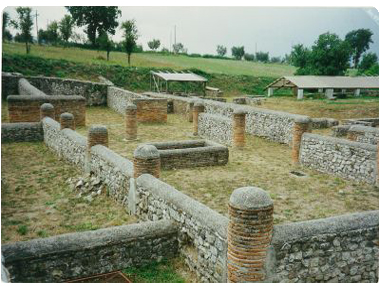 |
At a place called
today Passo di Mirabella, there was once the ancient city of Aeclanum. It
was originally one of the most important Samnite towns (oppida, in
Oscan), and at certain time the capital city of the Hirpini tribe; but
later on, when the Romans conquered it, became a renowned Roman centre
along the Appian Road.
The Samnite city met its doom when the Roman dictator, Cornelius Sulla,
destroyed it, in 89 B.C., during the Social War (91-87, B.C.). And
subsequently the same Sulla completed its destruction, when he put the
entire mountainous region of the Hirpini to fire and sword, as a
punishment for their participation as first-class fighting troops in the
last episode of the Civil War that opposed the late Marius’ allied forces
to Sulla’s, at Rome Porta Collina, on November 1, 82 B.C. Even if with
difficulties, Sulla won the battle and the war and soon after ordered that
the captured enemies should be slain in Rome Campus Martius.
Aeclanum was rebuilt by the Romans more splendidly than it was before the
destruction. But the city was already an important mountain pass in
Samnite times that shepherds used for transhumance, and regained and
increased its pre-eminence when the Appian Road was extended from
Benevento, in 190 B.C., and made to pass the Apennine mountain chain just
through the city.
Aeclanum was once again and definitely destroyed by the Byzantine emperor
Constantius II, during his expedition against the Longobards of Benevento
Duchy, in 662 A.D.
The most interesting point of this archaeological Park is precisely the
original tract of the Appian Road which crosses the city site in a West –
East direction, but of course there are also the beautiful Thermae ruins,
the Amphitheatre, etc.
We can appreciate the importance of the ancient Roman city from the large
number of epigraphs engraved on stone: there are well over 300 of them,
registered in the Corpus Inscriptionum Latinarum, ed. In Lypsia, 1883.
The most interesting, according to us, is the elogium M. Pomponius
Bassulus wrote himself for his tombstone. A poet and a playwright,
Bassulus was one of the artists who continued in Rome the “New Comedy”
tradition of the Greek Menander (see, Plinius Secundus, Ep. VI, 21).
We transcribe here only the first three lines of the original epitaph
registered with the n. 1164, vol. IX in C.I.L., ed. in Lypsia, 1883.
“NE – MORE – PECORIS – OTIO – TRANSFVNGERE(R)
MENANDRI – PAVCAS – VORTI – SCITAS – FABVLAS
ET – IPSVS – ETIAM – SEDVLO – FINXI – NOVAS…”
Our translation of the whole poem:
“As I wouldn’t pass my free time
as sheep do, some beautiful stories
of Menander’s I translated in our language
diligently;
and myself have composed some new ones,
whatever their merit, long since written on paper.
But my soul has been tormented with worries and anxieties
and my body with aches,
both of them very grievously,
till I gained the desired Death;
and she, as it is in her nature,
is giving me now all her comforts.
Please, let these words be engraved on my grave,
as a warning to posterity:
so that they may not cling on to the rocks of life
tenaciously, when it has been prepared
for those whom Life is forcing out,
a haven where everyone of us will find
a rest that never ends.
The last line of Bassulus’ epitaph is this:
“SET – IAM – VALETE – DONEC – VI(VERE – EXPED)IT”
“But, while life is propitious, stay well.”
(Sect. n. )
|

